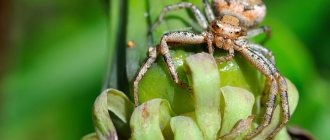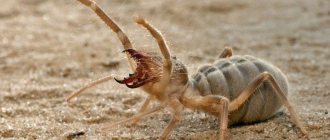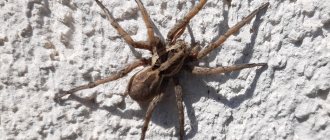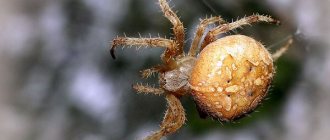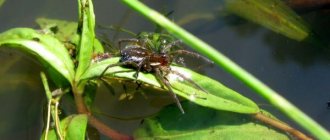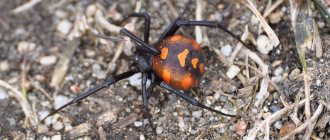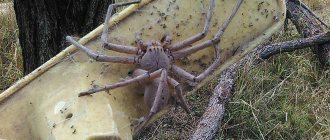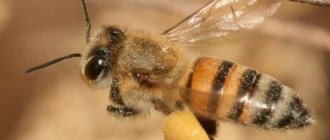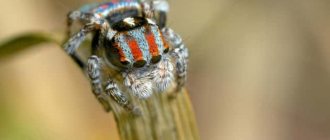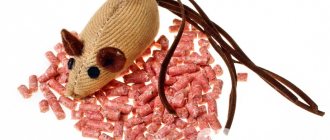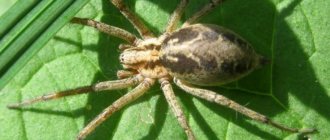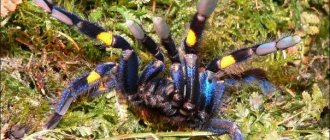You can meet the side-walking spider in any part of Europe. They move exclusively sideways, which is why they got their name. It won’t be easy to see them - thanks to their colors, they are like chameleons able to blend into their environment. They prefer to live among flowering grasses, which allows them to catch butterflies, flies and bees that make up the diet of these spiders. Depending on the weather, they can change their place of residence. During the rainy season, they prefer to seek shelter under the wide leaves of plants.
Body structure and coloring
Females are twice the size of males and can reach a length of 1-1.2 cm. Modified forelimbs allow spiders to move quickly and instantly pull food into their “embraces.” The color of these amazing creatures comes in almost all shades - white, pink, lemon, brown, green, red. The brightest representatives of this species live inside flower buds. Darker ones, with spots and patterns, live on the bark of trees and the ground. The white sidewalk spider is able to merge with the petals, as it has not only a milky body, but also eyes of the same shade.
Poisonous yellow spider
Yellow sak.
Another yellow spider is often found in Russia - the sak. This representative of the animal world is poisonous. But it’s difficult to confuse them - they are radically different.
Yellow sak has more of a beige or flesh tone, not as piercing neon. He prefers to settle in secluded places. Although it bites painfully, its activities are useful to people. Heiracanthium eats a large number of pests.
Peculiarities
Sidewalk spiders do not spin webs to catch flying insects. Female spiders make sacs from this sticky substance into which they lay their eggs. They also use webs to descend from taller plants to lower ones. But the most amazing thing is that with the onset of autumn they use it as a means of transport. Having ridden the bags, they are able to go on a long journey with the first gust of wind. In warm and dry weather, they cover a distance of several kilometers. Sometimes you can see a whole family of spiders on one web. To stop at a place they like, they simply shoot a web onto the nearest tree or plant.
Nutrition
Despite their body size, these arthropods are predators. They do not weave spider webs to catch prey. They only need the web for comfortable movement.
Small predators blend into their environment, waiting for their prey. They can remain absolutely motionless for a long time. They attack not only small insects - they also prey on those whose size is larger than the hunter.
During an ambush, cunning predators camouflage themselves, spread their forelimbs wide, preparing to attack instantly. If there is prey nearby, the arthropod approaches the victim and injects poison.
Toxic substances affect the victim’s nervous system, immobilizing it for a long time . This aggressive behavior is explained by the fact that the spider's front legs are equipped with claws, which contain a powerful poison that paralyzes prey.
When the victim is immobilized, the arthropod sucks all the vital juices out of it. Due to its weak jaw and small size, the sidewalker does not absorb its food entirely. Bumblebees, locusts, bees, and flies serve as food.
Hunter Tactics
Despite their size, spiders are not afraid to attack larger insects. Like real hunters, they can sit in ambush for a long time, waiting for prey with open paws. As soon as a butterfly or wasp lands on a flower, they instantly grab them and bite them in vulnerable places. Having injected the poison, the flower spider begins to eat. However, if a hunter has not eaten for a long time, then his behavior changes radically. He runs restlessly through the leaves, looking for prey and moving his paws in anticipation of lunch. At the sight of an approaching insect, the spider freezes with its legs wide open. From the outside it seems that he opened friendly arms. Thanks to their coloring, they manage to remain unnoticed, and the tactic brings the desired result.
Appearance
The length of an adult female reaches up to 10 mm, and the male is only 3 - 5 mm. On the front part of the muzzle there are paired organs (Chelicera) no more than 0.3 mm in length, at their ends there are poisonous spines with which it digs into the body of the victim and sprays a poisonous venom that causes instant paralysis.
The pedipalps are located next to the chelicerae. They resemble a pair of hands with which he holds food while eating it; males also have genitals at their ends. They serve for him to transfer sperm to the female.
Different types of spiders can have different colors
, here are just a few that we would like to focus on:
- light;
- greenish;
- yellowish;
- less often, intense tones;
Note! That its color can change dramatically depending on the flower on which it is going to ambush in order to catch the victim.
Reproduction
In early June, the mating season begins for sidewalk spiders. Males, like real gentlemen, court the female. If she considers the candidate worthy, then mating occurs. After a short break, the procedure is repeated, and after a while the female attaches cocoons wrapped in a web to the back of the leaves. Although this species does not tend to live surrounded by relatives, there are cases when a whole family of spiders lives on one plant.
Is yellow sak good for you?
Despite the fact that the yellow saka is dangerous to humans, it is considered a useful predator, as the spider kills more than 2,000 harmful larvae and insects per year, thereby helping people fight parasites.
Sources
- Guide to Medical Entomology / ed. V.P. Derbeneva-Ukhova. – M.: Medicine, 1974 – 359 p.
- Yatusevich, A.I. Little-studied infectious and parasitic diseases of domestic animals: textbook / A.I. Yatusevich, N.N. Androsik. – Minsk: Urajai, 2001 – 331 p.
- Parasitology and invasive diseases of farm animals / K.I. Abuladze [and others]. – M.: Agropromizdat, 1990 – 464 p.
- Workshop on parasitology and invasive animal diseases: textbook / A.I. Yatusevich [and others]. – Minsk: Urajai, 1999 – 279 p.
- Kapustin, V.F. Atlas of blood parasites of animals and exidid mites / V.F. Kapustin. – M.: State and agricultural literature, 1955 – 216 p.
- Diagnosis, therapy and prevention of parasitic diseases of horses. UMP for veterinary students and FPC students. / A.I. Yatusevich, S.I. Stasyukevich, M.P. Sinyakov, V.V. Petrukovich. / Vitebsk, VGAVM, 2011. 60 p.
- Bulanova-Zakhvatkina, E.M. Oribatid oribatid mites / E.M. Bulanova-Zakhvatkina. – M.: Higher School, 1967 – 254 p.
- Yatusevich, A.I. Eimeriosis of chickens and its parasitocenological aspects / A.I. Yatusevich, A.V. Sandul, V.N. Gisco. – Vitebsk: VGAVM, 2009 – 249 p.
- Parasitology and invasive diseases of farm animals / K.I. Abuladze, N.V. Demidov, A.A. Napoklonov and others; And. K.I. Abuladze. – 3rd ed. – M.: Agropromizdat, 1990 – 464 p.
- Balashov, Yu. S. Blood-sucking ticks (Ixodoidea) - carriers of human and animal diseases / Yu. S. Balashov. – L.: Nauka, 1967 – 320 p.
- Determinant of helminths of hunting mammals in Belarus: monograph / A. I. Yatusevich [et al.]. – Vitebsk: VGAVM, 2010 – 228 p.
- Veterinary and sanitary measures for the prevention and elimination of parasitic diseases of animals: methodological recommendations / I. N. Dubina [et al.]. – Vitebsk: VGAVM, 2008 – 51 p.
- Dubina I. N. Veterinary and sanitary standards for the prevention and elimination of cestodiasis in animals: approved. GUV MAHIP RB / I.N. Dubina, A.I. Yatusevich. – Vitebsk: VGAVM, 2007 – 10 p.
- Yatusevich A.I., Parasitic diseases of birds / A.I. Yatusevich, B.Ya. Birmansky, T.G. Nikulin. – Minsk: Publishing house “Polybig”, 2001.
- Olenev, N.O. Scabies mite / N.O. Olenev. - Gone. Academician Science of the USSR, 1932. – 64 p.
- Kuznetsov, M.I. Anoplocephalatosis of ruminants / M.I. Kuznetsov. – M.: Kolos, 1972.
- Stepanova, N.I. Protozoal diseases of animals / N.I. Stepanov. – M.-L.: Kolos, 1982.
- Processes of adaptation and parasitosis of animals: monograph / A.I. Yatusevich [and others]. – Vitebsk: Educational Institution VGAVM, 2006 – 404 p.
- Yatusevich A.I., Poorly studied infectious and invasive diseases of domestic animals / A.I. Yatusevich, N.N. Androsik. – Minsk: Urajai, 2001 – 332 p.
- Dubinina, M.N. Parasitological studies of birds / M.N. Dubinin. – L.: Nauka, 1971. – 139 p.
- Savchenko, S.V. Prevention and treatment of esophagostomal invasion of balantidiasis in pigs / S.V. Savchenko, V.F. Savchenko. – Vitebsk: VGAVM, 2010 – 194 p.
- Theoretical and practical basis for the use of medicinal plants for parasitic diseases of animals / A.I. Yatusevich [and others]. – Vitebsk: VGAVM, 2008 – 75 p.
- Dubinin, V.B. Scabies mites. Biology, harm in agriculture, prevention and control measures / V.B. Dubinin. -M.: Soviet Science, 1954. – 173 p.
- Yatusevich, A.I. Arachnoenthomosis of domestic ruminants and ungulates: monograph / A.I. Yatusevich [and others]. – Vitebsk: VGAVM, 2006 – 213 p.
- Subbotin, A. M. Boar sparganosis: differential diagnosis and improvement of measures to combat it in the conditions of the Republic of Belarus: teaching methods / A. M. Subbotin, N. F. Karasev, V. F. Litvinov. – Vitebsk: VGAVM, 2009 – 24 p.
- Yatusevich, A.I. Aymerosis of nutria: monograph / A.I. Yatusevich, V.A. Forget about it. – Vitebsk: OU VGAVM, 2006 – 87 p.
- Parasitology and invasive animal diseases / M.Sh. Akbaev [and others]. – M.: Kolos, 2000. – 743 p.
- Yatusevich, A.I. The Pratazoins lived in a trapped rural population. – Minsk: Urajai, 1993 – 174 p.
- Animal cryptosporidiosis (Recommendations for diagnosis, therapy and prevention). Approved by the Ministry of Agriculture of the State Administration and Administration of the Republic of Belarus on July 25, 2000 Authors: Yatusevich A.I., Savchenko V.F., Nesterovich S.G. et al.
- Balashov, Yu. S. Blood-sucking arthropods and rickettsia / Yu. S. Balashov, A.B. Daiter. – L.: Nauka, 1973 – 251 p.
- Parasitology and invasive animal diseases / M.Sh. Ak-baev, A.A. Vodyanov, N.E. Kosminkov and others; And. M. Sh. Akbaeva. – M.: Kolos, 2002 – 743 p.
- Recommendations for the fight against helminthiasis in horses / A.I. Yatusevich [and others]. – Vitebsk: VGAVM, 2008 – 15 p.
- Dubinin, V.B. Scabies mites. Biology, harm in agriculture, prevention and control measures / V.B. Dubinin. -M.: Soviet Science, 1954. – 173 p.
- Agrinsky, N.I. Insects and mites that harm farm animals / N.I. Agrinsky. – M.: Selkhozizdat, 1962 – 288 p.
- Sokolova, T.V. Shchesotka / T.V. Sokolova, R.F. Fedorovskaya, A.B. Lange. – M.: Medicine, 1989 – 176 p.
- Yatusevich, A.I. Veterinary and medical parasitology: (Encyclopedic reference book) / A.I. Yatusevich, I.V. Rachkovskaya, V.M. Kaplich. – M.: Medical literature, 2001 – 309 p.
- Yatusevich, A.I. Eimeriosis of chickens: monograph / A.I. Yatusevich, V.N. Gisco. – Vitebsk: OU VGAVM, 2007 – 103 p.
- Karasev, N.F. Larval cestodosis of animals / N.F. Karasev, T.G. Nikulin, N.K. Slepnev. – Minsk: Urajai, 1989 – 111 p.
- Kapustin, V.F. Atlas of helminths of farm animals. – M.: Selkhozgiz, 1953. – 139 p.
- Dubina I. N. Guidelines for the diagnosis of carnivorous helminthiases: approved. GUV MAHIP RB / IN Dubina. – Vitebsk: VGAVM, 2008 – 32 p.
- Yatusevich, A.I. Helminth infections of cattle and measures to combat them under environmental stress / A.I. Yatusevich, R.N. Protasovitskaya. – Vitebsk: VGAVM, 2010 – 160 p.
- Veterinary laboratory practice. T. 2. – M.: Selkhozizdat, 1963. – 432 p.
- _https://domvred.ru/zheltyj-pauk-sak-xejrakantium/
- Orlov, I.V. Workshop on veterinary parasitology / I.V. Orlov, N.I. Agrinsky, S.N. Nikolsky. – M.: Selkhozizdat, 1962 – 319 p.
- Practical parasitology / ed. D. V. Vinogradov-Volzhinsky. – L.: Medicine, 1977 – 304 p.
- Antiparasitic drugs for dogs and cats: compensation for damage / AI Textbook Yatusevich [et al.]. – Vitebsk: VGAVM, 2009 – 48 p.
- Shershen, G.G. Methodological recommendations for identifying natural foci of piroplasmosis in animals in Belarus / G.G. Shershen, N.F. Karasev. – Vitebsk: VGAVM, 2009 – 32 p.
- Midges and simulidotoxicosis in cattle. / Skulovets M.V. / -2007
- Parasitic diseases of horses / A.I. Yatusevich [and others]. – Minsk, 1999 – 78 p.
- Kaplich, V. M. Vile and measures to combat it in Belarus / V. M. Kaplich, A. I. Yatusevich, M. V. Skulovets. – Minsk: Urajai, 1994 – 120 p.
- Dubina, I.N. Guidelines for the diagnosis of larval cestodiasis in animals / I.N. Club. – Vitebsk: VGAVM, 2008 – 39 p.
- Diseases of agricultural animals / P.A. Krasochko [and others]; edited by DAD. Beautiful. – Minsk: Businessofset, 2005 – 800 p.
[/spoiler]
Is it dangerous for humans?
The venom of this predator is very toxic and can instantly paralyze the victim. But fortunately for man, his concentration is not strong enough. Contrary to popular belief, representatives of this species, which are brightly colored, do not themselves attack people. They sense danger very well and will not take risks, knowing that they will lose this battle. Don't be afraid if a spider bites a pet - your pet most likely won't even notice. But smaller representatives of the fauna may feel a slight malaise and disorientation. Mice, rats, hamsters and other rodents should not be kept near sidewalk spiders.
Recommendations for a bite
Sidewalkers rarely attack humans. Their bites are not particularly dangerous, but they cause discomfort.
Symptoms of a sideworm bite:
- slight red swelling of the affected area;
- itching and burning;
- pain in the head, malaise, dizziness;
- general weakness.
For treatment, it is recommended to use ice by placing it on the affected area. Antihistamines will come to the rescue. The bite area is treated with “Asterisk” ointment. It should be remembered that this species has poisonous glands.
Keeping at home
This animal can make an excellent pet. They are unpretentious in food and do not require much space. The terrarium must be at least 40 cm long and 30 cm wide. Particular attention should be paid to humidity - the sidewalk spider will die if it ends up in a dry, closed container. The temperature should be within 20 degrees. For food, you need to select insects that are no larger than the size of a spider. Flies, cockroaches, and crickets are ideal. With proper care, spiders live 2-3 years.
Competition “Bio/Mol/Text”-2020/2021
This work was published in the “Own Work” category of the “Bio/Mol/Text” competition - 2020/2021.
The nomination partner is the Russian Science Foundation.
The general partner of the competition is the annual biotechnology conference BiotechClub, organized by the international innovative biotechnology company BIOCAD.
The sponsor of the competition is SkyGen: a leading distributor of life science products on the Russian market.
Competition sponsor: the largest supplier of equipment, reagents and consumables for biological research and production.
"Book" sponsor of the competition - "Alpina Non-Fiction"
Interesting facts about sidewalkers
- Some species have the ability to slowly change their color.
- Before mating, the male brings his lady a gift in the form of an edible insect.
- Some people specifically bring home cockroaches to get rid of cockroaches.
- Spiders are able to distinguish the sounds of music and even “dance.”
- They distinguish relatives at a distance of up to 5 meters.
- Because of their style of moving sideways, they are called crab spiders.
- Some species hunt exclusively at night, waiting for moths inside a flower.
- They do not attack insects that are much smaller in size than the spider’s body.
- Farmers move sidewalkers to their fields to get rid of pests.
- Due to the small size of the fangs, they are not able to bite through human skin.
Lifestyle
The side-walking spider is one of the few animals that does not weave webs; its huge advantages are:
- Powerful front legs;
- Ability to camouflage perfectly;
- Immobility;
Why, you ask, did we mention the word: “immobility”. Of course, camouflage is one of the most successful advantages that it uses during hunting, but immobility also plays an important role in the hunting process.
While scientists were observing different species of these spiders, it was recorded that a sitting spider on a red flower inflorescence had a white color and could successfully catch bumblebees, locusts, crickets, hornets, bees and flies. This makes it clear that its immobility during the hunt is as much an advantage as its camouflage.
Literature
- J. Defrize, M. Thery, J. Casas. (2010). Background color matching by a crab spider in the field: a community sensory ecology perspective. Journal of Experimental Biology
.
213 , 1425-1435; - Jérémy Defrize, Claudio R. Lazzari, Eric J. Warrant, Jérôme Casas. (2011). Spectral sensitivity of a color changing spider. Journal of Insect Physiology
.
57 , 508-513; - Angus J. (1882). Protective change of color in a spider. Am. Nat. 16, 10109;
- Gabritschevsky E. (1927). Experiments on the color changes and regeneration in the crab spider Misumena vatia (Cl.). J. Exp. Zool. 47, 251–267;
- de Kerville HG (1907). Sur l'homochromieprotectrice des femelles de Misumena vatia Clerck. Bull. Soc. Entomol. Fr. 1907, 145–146;
- Packard AS (1905). Change of color and protective coloration in a flower-spider (Misumena vatia Thorell). J. NY Entomol. Soc. 13, 85–96;
- Pearse AS (1911). The influence of different color environments on the behavior of certain arthropods. J. Anim. Behav. 1, 79–110;
- Gertrud Weigel. (1942). Farbung und Farbwechsel der Krabbenspinne Misumena vatia (L.). Z.Vergl.
Physiol. .
29 , 195-248; - Tyshchenko V.P. Key to spiders of the European part of the USSR. Leningrad: “Science”, 1971. - 281 p.;
- Bagrova T.N. and Drozdov V.V. (2010). The influence of large-scale atmospheric circulation on the climatic parameters of the Western Caucasus (Teberda Biosphere Reserve). "Scientific notes of the Russian State Hydrometeorological University." 13, 52–63;
- Karabanova I.V. (2013). Ecological and geographical aspects of sustainable development of the North Caucasus economic region (using the example of the Stavropol Territory). “Bulletin of Russian Universities. Mathematics". 2, 620–624;
- Kuranova N.G. and Kupatadze G.A. (2018). Synanthropization of the flora in the vicinity of the village of Pavlovskaya Sloboda. "Systematic and floristic studies of Northern Eurasia: materials of the II international conference." 85–89;
- Kuranova N.G., Viktorov V.P., Kupatadze G.A. (2018). Some aspects of the dynamics of the flora in the vicinity of the village of Pavlovskaya Sloboda (Moscow region). "Ecology and geography of plants and plant communities: materials of the IV international scientific conference." 489–492;
- The great combinator never dreamed of: combinatorics of spider toxins;
- "Smart" glue from spider webs;
- Technology of using spider webs in medicine;
- How to make spiders work for us?;
- Seifulina R.R. and Kartsev V.M. Spiders of the European part of Russia. M.: “Fiton XXI”, 2022. - 432 pp.;
- Lisa A. Taylor, Emily B. Maier, Kevin J. Byrne, Zarreen Amin, Nathan I. Morehouse. (2014). Color use by tiny predators: jumping spiders show color biases during foraging. Animal Behavior
.
90 , 149-157.
Spreading
The flower spider is widespread in North America and Eurasia. Its range on the American continent extends from Alaska to the southern borders of the United States, and in Europe from Iceland and Scandinavia to the Mediterranean coast.
Presumably the American population descends from spiders brought by European settlers. In Asia, clubfoot mizumena live in the temperate zone from southern Russia to Japan.
They inhabit sunlit meadows, fields and forest edges. In urban areas, gardens and parks are used, and places that are too wet and shady are strictly avoided.
Argiope Brünnich's web.
Like all orb weavers, the wasp spider is fluent in the art of weaving webs, and its spiral trapping nets are large wheel-shaped nets with two pronounced stabilimentum in the middle.
The stabilimentum is a thickened zigzag pattern on the web, which can have different shapes: linear, circular, cruciform.
A notable feature of the wasp spider’s web is that there are two such patterns at once, which diverge from the middle and are located opposite each other. Scientists have found that the main reason for this artistic weaving is the ability of the multilayer insert to reflect ultraviolet rays, thereby attracting insects.
The wasp spider weaves a complex web of multilayer threads thanks to the structure of the limbs characteristic of orb-weavers. The last pair of legs, equipped with three simple claws and serrated setae, has a special spike-shaped appendage that allows it to weave intricate webs from individual threads.
The female, sitting in the center of the web (usually upside down), resembles the letter “X” because her widely spaced legs of the first and second, as well as the third and fourth pairs are placed very close to each other.
The wasp spider, like most representatives of the order, weaves its web at dusk, and the whole process lasts no more than an hour. Typically, the web stretches between plants no higher than 30 cm from the surface of the ground. In case of danger, a disturbed wasp spider throws its catching nets and tries to hide on the ground.
